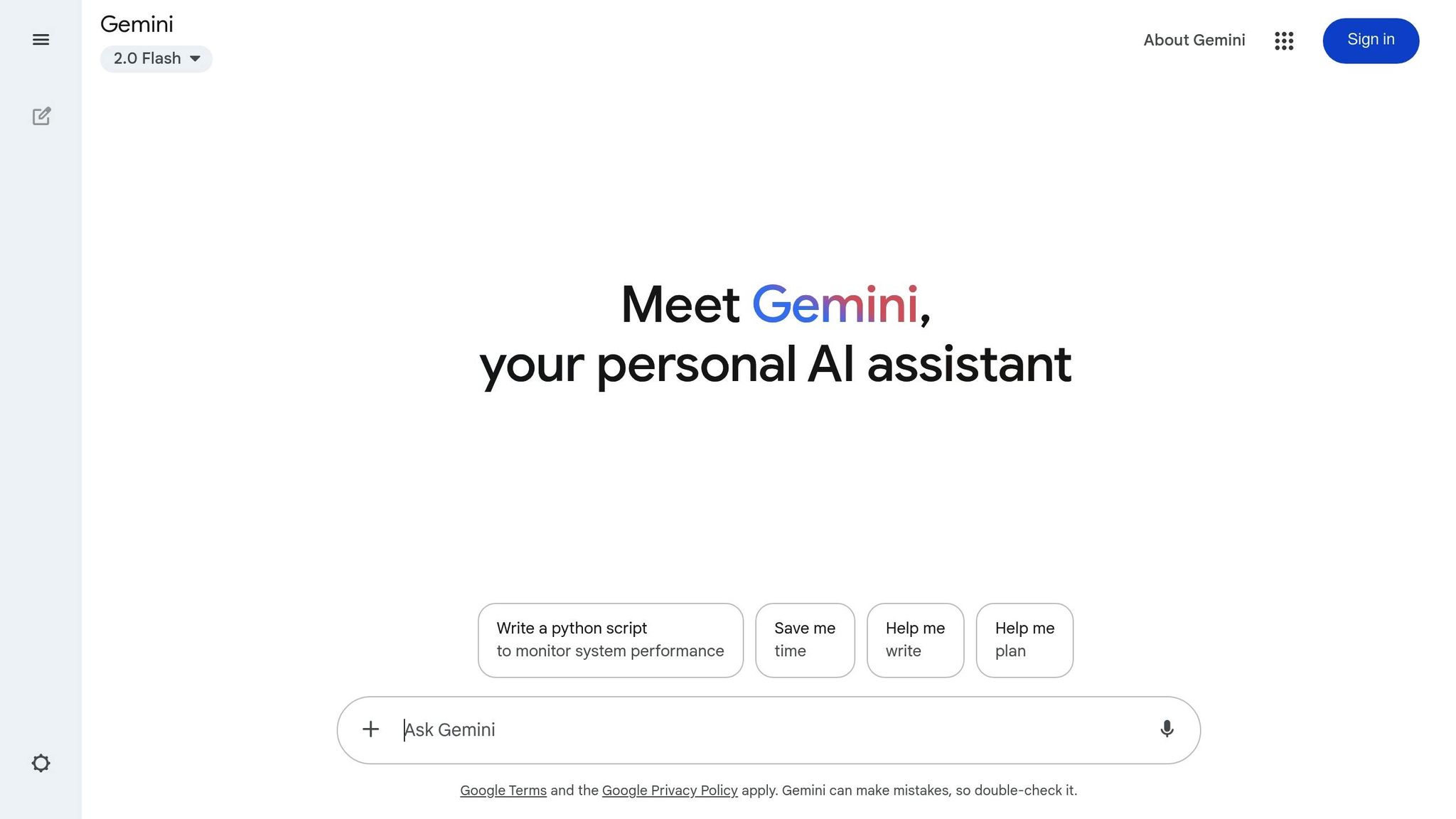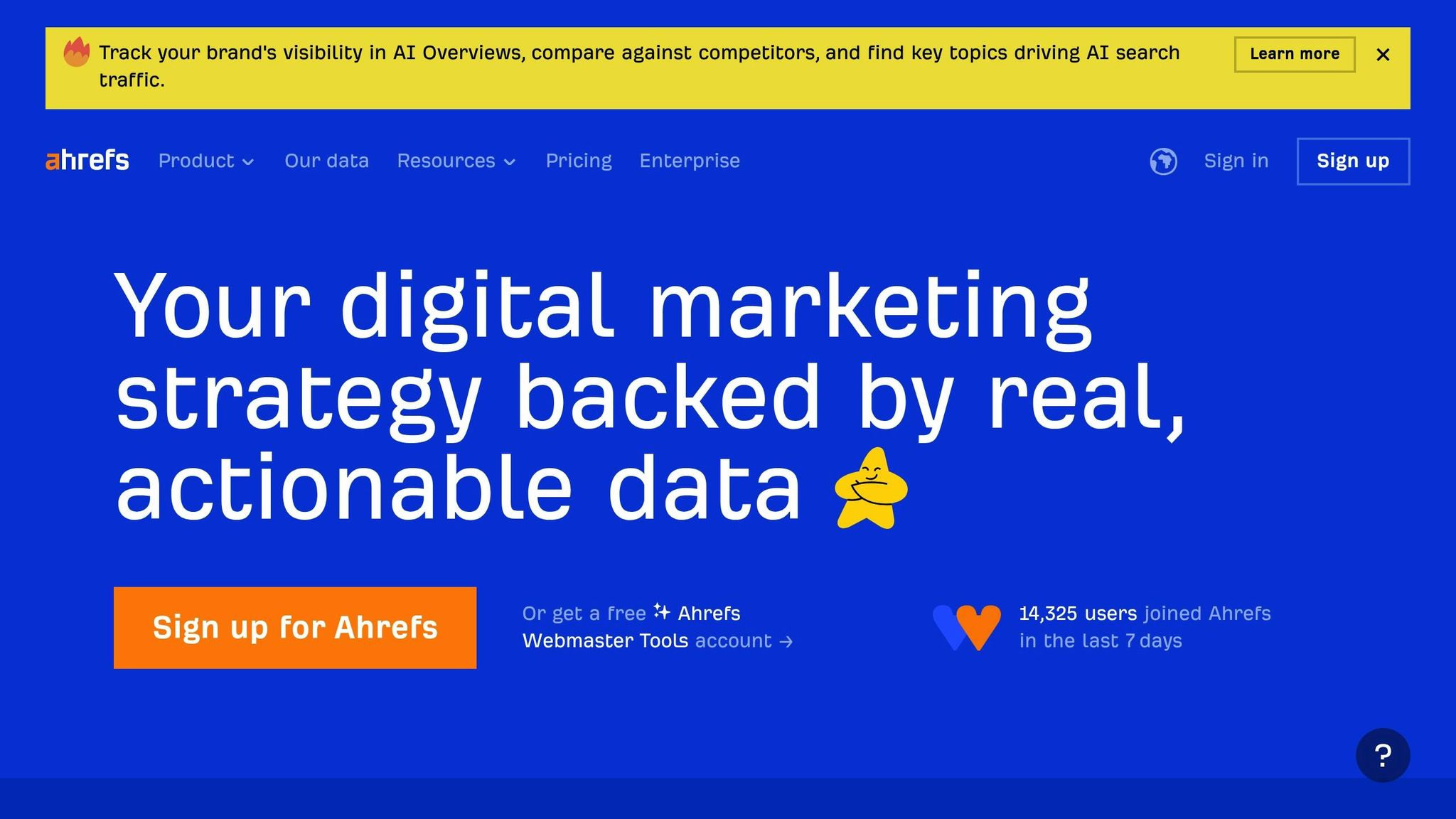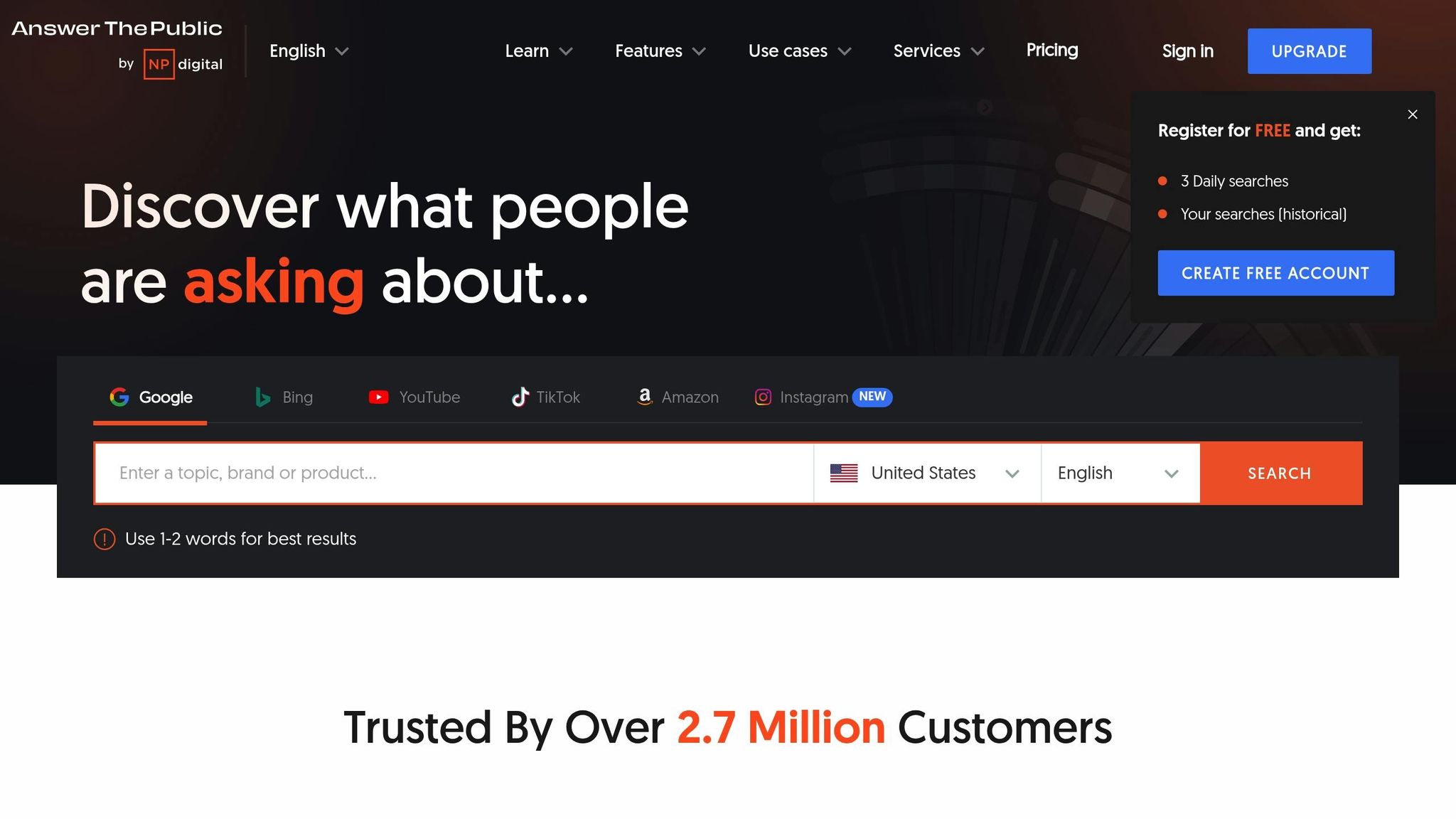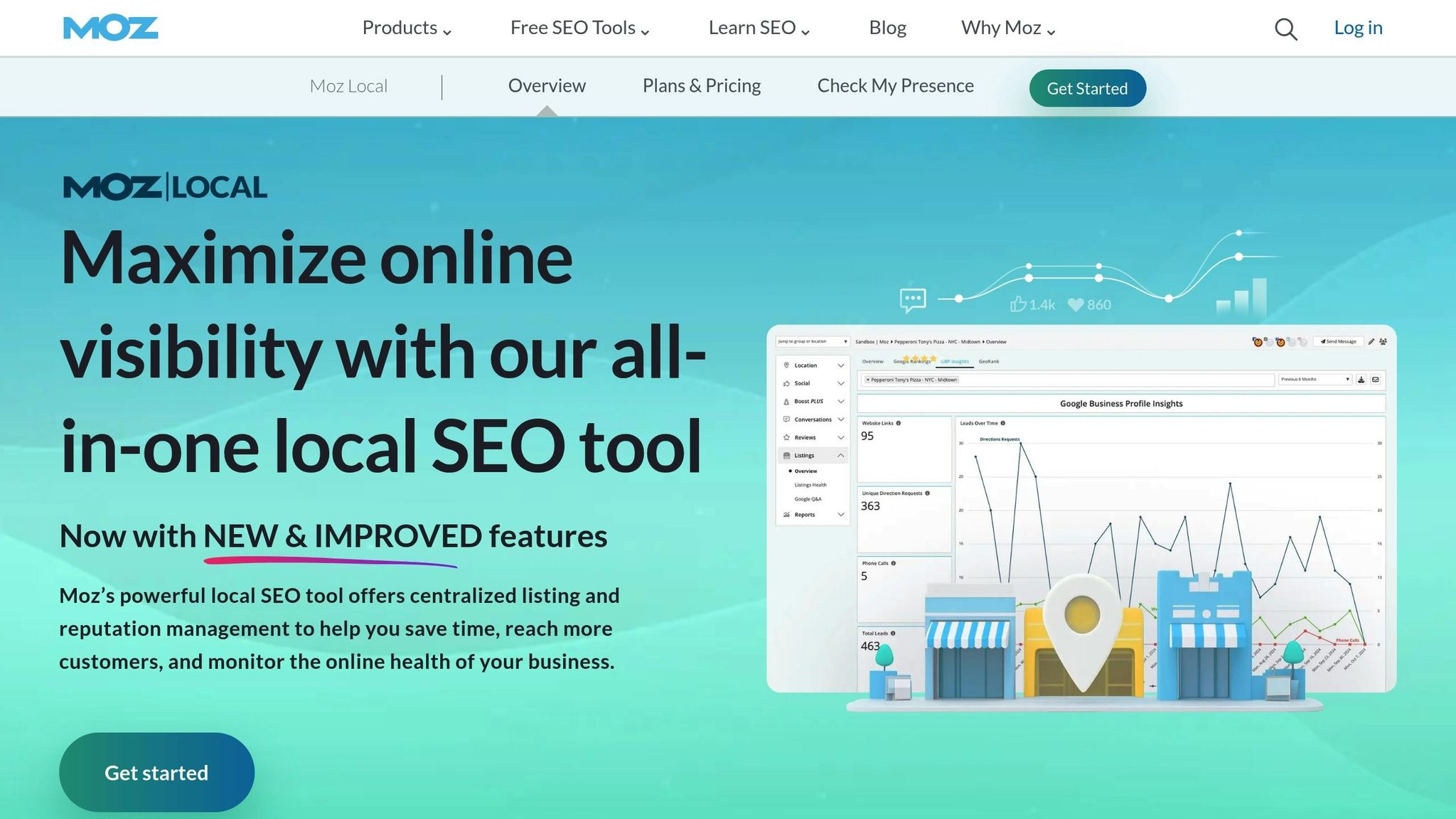Voice search is transforming how people find information, making it essential for businesses to adapt. This article covers top AI tools that help optimize for voice search by focusing on conversational queries, long-tail keywords, and local SEO. Here’s a quick summary:
- Google Bard: Creates conversational content with natural language processing and intent recognition.
- SEMRush: Tracks voice-specific rankings, analyzes long-tail keywords, and identifies common questions.
- Ahrefs: Finds conversational queries with its Questions Report and analyzes voice search patterns.
- AnswerThePublic: Maps natural language questions and provides content ideas for voice queries.
- Jasper AI: Generates voice-optimized content with features like FAQ creation and brand voice consistency.
- Moz Local: Improves local SEO by managing business listings and adding structured data.
- Joxdigital: Offers customized voice SEO services, including schema markup and question-based content.
Quick Comparison
| Tool | Key Features | Best For | Pricing (Monthly) |
|---|---|---|---|
| Google Bard | Natural tone, intent recognition, free usage | All businesses | Free |
| SEMRush | Voice analytics, keyword tracking | Medium–Large enterprises | $129.95+ |
| Ahrefs | Question-based keywords, voice intent filter | Small–Large businesses | $99+ |
| AnswerThePublic | Visual question mapping, content ideation | Content creators | Free–$99 |
| Jasper AI | FAQ generator, brand voice training | Content teams | $39–$59+ |
| Moz Local | Local SEO, structured data | Multi-location businesses | $84–$240 |
| Joxdigital | Custom voice SEO services | Competitive industries | $2,500+ |
Each tool offers unique features to help businesses succeed in voice search. Dive into the article for details on how these tools can boost your voice search strategy.
Boost Your Business with AI and Voice Search Optimization
1. Google Bard: Voice Search Features

Google Bard is an AI tool designed to help create content that works well for voice search. It focuses on maintaining a conversational and natural tone, which is key for this type of search. When used as part of a well-thought-out SEO strategy, it can deliver strong results, especially with professional guidance.
Working with an experienced SEO agency can help businesses make the most of voice search technology. For instance, Joxdigital offers customized SEO services and training to help businesses integrate tools like Google Bard into their digital marketing efforts.
Here are some standout features of Google Bard for voice search:
- Natural Language Processing: Helps craft content that feels more conversational.
- Intent Recognition: Ensures user queries are understood and addressed effectively.
- Contextual Analysis: Matches content to the specific context of voice searches.
Joxdigital’s "Voice Search Analytics Checklist for 2025" offers a structured way to include voice search optimization in broader SEO strategies. Combining Google Bard with expert SEO insights can lead to content that not only ranks well but also connects with users.
2. SEMRush Voice Search Tools

SEMRush has developed tools to help businesses refine their voice search strategies, combining analytics with a natural tone approach inspired by Google Bard. Their AI-powered voice search suite focuses on tapping into the growing voice search trend. For instance, the Voice Search Position Tracking filter pinpoints valuable keywords, especially natural language and "near me" queries.
The Keyword Magic Tool is another standout feature, analyzing question-based and long-tail keywords that are crucial for voice search. With 62% of voice searches consisting of four or more words, targeting conversational language is key.
Additionally, the Questions Report compiles commonly asked questions, which is important since 80% of voice search answers come from the top three results, and 60% of these are featured snippets.
Here’s a quick look at what SEMRush tools offer:
| Feature | Capability | Impact |
|---|---|---|
| Position Tracking | Tracks voice-specific rankings | Increases chances of featured snippets |
| Topic Research | Suggests natural language questions | Boosts visibility in voice search |
| Content Template | Builds voice-optimized content | Enhances mobile search performance |
One success story involves a fitness app that increased its voice search traffic by 30% in just six months using SEMRush’s question-based keyword recommendations.
Looking ahead, SEMRush plans to launch a Voice Search Analytics Dashboard in Q3 2025, powered by GPT-4. Early tests show it can identify emerging voice queries 20% more effectively than current tools.
For businesses aiming to optimize for voice search, SEMRush offers tiered pricing starting at $129.95 per month. The Business plan, priced at $499.95 per month, includes advanced features like API access and detailed analytics.
3. Ahrefs Voice Search Keywords

Ahrefs’ Keywords Explorer has stepped into the voice search SEO game with features designed to handle the unique challenges of voice queries. Their Questions report uses a massive database of 19.4 billion keywords to identify patterns that work well for voice searches. Data shows that 91% of voice search answers appear in the top 5 results.
Here’s a quick look at some of the standout features:
| Feature | Purpose | Performance Boost |
|---|---|---|
| Questions Report | Finds natural, conversational queries | 21.3% CTR compared to 13.3% for standard keywords |
| Parent Topic Analysis | Links related topics semantically | Enhances topic alignment |
| Voice Intent Filter | Examines conversational search patterns | Helps achieve rankings 22% faster |
These tools highlight how Ahrefs is addressing voice search in a way that sets it apart.
Voice search is becoming more common, with 27% of mobile searches now using voice input. On average, voice queries are 29 words long. For example, Bird Marketing saw a 37% traffic increase in Q3 2024 by focusing on "how to" phrases with monthly search volumes between 200 and 500.
"The integration of GPT-4 in our voice query prediction has shown a 15% improvement in intent matching accuracy during beta testing", according to Ahrefs’ recent development report.
To succeed with voice search, focus on these types of keywords:
- Local intent modifiers tailored for voice searches
- Popular question-based formats
- Keywords with difficulty scores under 30 and proven voice search results
- Monthly search volumes ranging from 200 to 2,000
Ahrefs’ Content Gap Analysis is another standout tool, helping users uncover conversational queries that competitors may have missed. For instance, Content Whale reduced keyword difficulty by 42% using this feature.
Ahrefs is also working on new tools specifically for voice search, including difficulty scores tailored for voice queries and automatic answer schema generation. This is especially important because 40.7% of voice search answers come from featured snippets.
With 65% of adults aged 25-49 using voice search daily, Ahrefs’ focus on natural language processing ensures content is aligned with how people speak, not just how they type. Their tools are essential for staying ahead in the voice search landscape.
4. AnswerThePublic Question Research

AnswerThePublic uses AI to analyze billions of daily searches, turning them into insights that reflect how people naturally interact with voice assistants. It features search suggestion wheels that visually map out common language patterns, providing a clear picture of how users phrase their queries.
The platform organizes question-based searches into key categories:
| Question Type | Voice Search Pattern | Optimization Focus |
|---|---|---|
| Who/What/Where | Everyday speech patterns | Targeting featured snippets |
| Comparison (vs/or) | Decision-making queries | Optimizing for rich answers |
| Prepositions | Location-based searches | Improving local SEO efforts |
These groupings make it easier to create voice search-friendly content. With its ability to process over 3 billion searches daily, the tool identifies 20% entirely new queries every day. This is especially helpful since 72% of voice-activated speaker users rely on voice search for local business details.
In March 2025, AnswerThePublic introduced updates like real-time trend alerts, AI-generated content briefs with voice-specific KPIs, and integration with smart speaker usage data. For instance, Healthline used these new features to cut their voice search content update cycle from 6 months to just 3 weeks, allowing them to respond quickly to shifting trends.
Sweet Talk, a bakery in Texas, leveraged the Pro plan ($99/month) to analyze over 120 voice queries. This approach boosted voice-initiated orders by 90% through improved local search strategies.
The tool’s visual question wheels help structure content to fit voice assistant responses. HubSpot found a 40% increase in featured snippet appearances when they aligned their content with these question categories. Similarly, The Kitchn paired these insights with schema markup, leading to a 25% rise in voice-driven recipe traffic during Q1 2025.
AnswerThePublic continues to refine its offerings. Its latest update integrates GPT-3.5, speeding up content creation while ensuring natural language flow. It also now supports 83 languages, enabling businesses to optimize for voice search across global markets.
5. Jasper AI Content Creation

Jasper AI uses advanced natural language processing (NLP) to create conversational content tailored for voice search. Its Brand Voice feature is particularly impressive, maintaining a consistent tone with 89% accuracy across voice-optimized content.
Here’s a breakdown of Jasper AI’s voice search optimization features:
| Feature | Voice Search Benefit | Performance Metric |
|---|---|---|
| FAQ Generator | Targets featured snippets | 78% success rate |
| Brand Voice Training | Ensures consistent responses | 89% accuracy |
| SEO Mode | Matches voice queries effectively | 65% visibility increase |
| Language Support | Optimizes globally | Covers 29 languages |
Jasper’s structured approach has shown real-world results. For example, in the home services sector, Jasper-generated FAQ pages improved voice search visibility by 65%, securing featured snippet positions for 78% of targeted voice queries.
Another standout tool is the Structured Data Assistant, which reduces manual schema markup time by 60%. This automation not only saves time but also directly improves search rankings.
Limitations and Improvements
While Jasper offers robust features, it’s not without its flaws. For instance, users must manually input URLs for new trends, and about 15% of the content still requires human editing. However, Jasper’s continuous learning system has been addressing these issues, reducing the need for manual adjustments by around 7% each month.
Pricing Plans
Jasper AI offers flexible pricing tiers to suit different needs:
| Plan | Monthly Cost | Key Voice Features |
|---|---|---|
| Creator | $39 | Single Brand Voice, Basic SEO Tools |
| Pro | $59 | Three Brand Voices, Advanced SEO |
| Business | Custom | Unlimited Voices, API Access |
For added functionality, users can enable the "Include Google Search data" toggle, which integrates real-time query insights. Combined with SEO Mode and Brand Voice, this feature helps align content with both search algorithms and natural speech patterns.
Recent updates have focused on enhancing voice search capabilities, especially for ecommerce. AI-generated voice search content in this sector has grown by 38% year-over-year. Jasper’s inclusion in Forrester’s 2024 AI Writing Tools Report highlights its effectiveness in maintaining brand consistency while optimizing for voice search results.
sbb-itb-26b48df
6. Joxdigital Voice SEO Services

Joxdigital helps businesses stand out in voice search results by combining technical SEO know-how with natural language optimization. Using established voice search tools, they customize their services to meet specific market demands.
Key Voice SEO Features
| Service Component | How It Works | Voice Search Impact |
|---|---|---|
| Question-Based Content | FAQ schema markup and targeting featured snippets | Delivers direct answers to users |
| Natural Language Analysis | Maps conversational keywords and matches user intent | Improves relevance for queries |
| Technical Voice SEO | Focuses on speed and mobile-first indexing | Prepares sites for voice search |
| Voice Schema Markup | Adds structured data, including local business info | Enhances search context |
These features align with the conversational and technical needs of voice search.
Optimization Approach
Joxdigital’s voice SEO strategy is built on three main areas:
- Natural Language Processing
Focuses on analyzing voice queries to optimize for long-tail conversational keywords and question-based searches. - Technical Implementation
Includes schema markup, mobile-first indexing, and creating a site architecture designed for voice search. - Content Optimization
Develops content with FAQ formats, clear and concise answers, and localized details.
Service Packages
Joxdigital offers three service tiers to integrate voice optimization with broader SEO strategies:
- Silver Package ($2,500): Designed for startups and local businesses, includes tracking up to 50 voice-optimized keywords and monthly performance reports.
- Gold Package ($4,500): Ideal for small to medium businesses in competitive industries, optimizes up to 25 pages for voice search and enhances local and conversational search relevance.
- Platinum Package ($8,000): Best for highly competitive markets, this package optimizes up to 50 pages, tracks 200 voice-optimized keywords, and provides weekly performance updates.
7. Moz Local Voice Search Tools

Moz Local helps improve local visibility, which plays a key role in voice search SEO. By maintaining accurate and consistent business listings, you can ensure voice assistants provide dependable answers. Follow these steps to get the most out of Moz Local for voice search:
Tips for Optimizing Voice Search with Moz Local
- Keep Business Information Accurate and Up-to-Date
Make sure your business name, address, and phone number (NAP) are consistent everywhere. Update your business hours and special schedules regularly. - Leverage Structured Data and Schema Markup
Add LocalBusiness schema to make it easier for search engines to understand your business details. Including FAQs that reflect common voice queries can also enhance your structured data. - Monitor and Make Adjustments
Keep your business listings current. Use analytics to identify areas where you can improve performance further.
Tool Features Comparison
Compare AI tools for voice search SEO by examining their features, pricing, and performance metrics to make informed decisions.
Core Features and Pricing Structure
| Tool | Key Voice Features | Monthly Cost | Best For |
|---|---|---|---|
| Google Bard | Natural Language Processing, Featured Snippet Optimization | Free | All Business Sizes |
| SEMRush | Voice Search Analytics (142M+ keywords), Competitor Analysis | $129.95 | Medium–Large Enterprises |
| Ahrefs | Long-tail Keyword Analysis (10B+ index), Question Research | $99 | Small–Large Businesses |
| AnswerThePublic | Question Mapping, Content Ideation | Free–$99 | Content Creators |
| Jasper AI | Voice-Optimized Content (50+ templates) | $49 | Content Teams |
| Moz Local | Local Voice Search Management | $84–$240 | Multi-location Businesses |
Each tool’s core features play a crucial role in enhancing performance, as detailed below.
Performance Metrics
- SEMRush: Users have reported a 41% boost in voice search rankings within six months. Best Buy, for instance, used SEMRush’s Voice Search Analytics to achieve a 37% increase in voice search traffic by optimizing specific queries like "best wireless headphones under $200".
- Jasper AI: Content created with Jasper AI sees 35% higher rates of achieving "position zero" in search results.
Integration Capabilities
- Jasper AI: Integrates with WordPress, SurferSEO, and Grammarly for seamless content creation.
- Moz Local: Works with Google Business Profile, Yelp, and Apple Maps to manage local voice search.
- SEMRush: Includes Shutterstock integration to enhance voice-visual content strategies.
Business Size Suitability
SEMRush stands out for enterprise-level users with its detailed analytics, offering deeper insights into voice search trends.
Multilingual Support
- Google Bard: Supports 43 language variants, making it versatile for global use.
- SEMRush: Tracks Spanish keywords across 18 Latin American markets, helping businesses engage diverse U.S. audiences effectively.
ROI Considerations
Here are expert-recommended tool combinations to maximize return on investment:
| Purpose | Tool Combination | Monthly Investment | Expected Outcome |
|---|---|---|---|
| Research | SEMRush + AnswerThePublic | $228.95 | 22% higher FAQ visibility |
| Content Creation | Jasper AI + Grammarly | $61 | 35% featured snippet increase |
| Local Optimization | Joxdigital + Moz Local | $584+ | 73% improvement in local voice search rankings |
Trial Availability
- SEMRush: 7-day trial for $0.99
- Jasper AI: 7-day free trial
- AnswerThePublic: 3 free queries daily
- Google Bard: Unlimited free use
- Joxdigital: Free voice search audit for new users
Choosing tools that match your business goals and budget can lead to measurable improvements in voice search visibility.
What’s Next in Voice Search AI
AI tools have already revolutionized voice search, and the next wave of advancements promises even sharper capabilities. Businesses are now focusing on tracking voice search analytics to gain a better understanding of user behavior and search intent. These tools are becoming key to staying ahead in the digital world.
Developments in natural language processing and voice recognition are making it easier to interpret complex voice queries. With improved voice analytics, companies can fine-tune their content strategies to provide more accurate answers to user questions. Moving forward, using these advanced tools to adapt content strategies will be crucial for businesses looking to stay competitive in the ever-changing digital landscape.
Conclusion
To excel in voice search, businesses should combine the discussed AI tools and SEO strategies. Using data-driven insights alongside broader SEO efforts can improve performance and adaptability in this growing area.
The key to success lies in a unified approach. High-quality content remains essential – AI tools can assist in crafting content that appeals to both users and search engines. Focusing on this content-first strategy, paired with thoughtful voice search techniques, creates a strong digital presence.
Prioritize data analysis, content refinement, and cohesive strategy to turn AI insights into actionable voice search improvements. Equipping teams with the right training ensures these advanced methods are effectively implemented.
Voice search optimization is evolving, blending AI advancements with expert strategies to address emerging challenges. Businesses that focus on ongoing training, data-driven practices, and consistent content quality will elevate user experience and achieve tangible results in this competitive space.
FAQs
How can businesses use AI tools to enhance their voice search SEO strategies?
Businesses can integrate AI tools into their voice search SEO strategies by focusing on optimizing content for natural, conversational language. AI-powered tools can analyze search patterns and help tailor content to match how people speak during voice searches. These tools also assist in identifying long-tail keywords and question-based phrases commonly used in voice queries.
Additionally, AI can help improve website performance by analyzing user behavior, optimizing page speed, and enhancing mobile compatibility – all of which are crucial for voice search rankings. Implementing these tools ensures your content aligns with user intent and improves visibility in voice search results.
How is optimizing content for voice search different from text-based search?
Optimizing for voice search focuses on how people naturally speak, while text-based search prioritizes how users type. Voice search queries tend to be longer and more conversational, often phrased as complete questions, like ‘What’s the best pizza place near me?’. In contrast, text searches are typically shorter and more fragmented, such as ‘best pizza near me.’
To optimize for voice search, it’s important to use natural language, focus on long-tail keywords, and provide concise answers to common questions. Additionally, voice search often prioritizes local results, so ensuring your business information is accurate and up-to-date is crucial for visibility in local searches.
How do AI tools like Google Bard and SEMrush improve understanding of user intent in voice search queries?
AI tools like Google Bard and SEMrush help enhance the understanding of user intent in voice search by analyzing natural language patterns and context. These tools use advanced machine learning algorithms to interpret conversational queries more accurately, identifying the specific needs or goals behind a user’s spoken words.
For example, they can recognize nuances like question phrasing, regional dialects, and intent (e.g., informational, transactional, or navigational). This allows businesses to optimize their content for voice search, ensuring it aligns better with how users naturally speak and search online.
